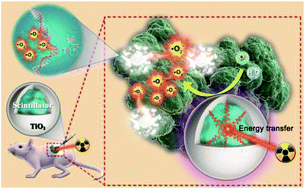Scintillator-based radiocatalytic superoxide radical production for long-term tumor DNA damage†
Abstract
Photocatalytic materials absorb photons ranging from the ultraviolet to near-infrared region to initiate photocatalytic reactions and have broad application prospects in various fields. However, high-energy ionizing radiations are rarely involved in photocatalytic research. In this study, we proposed a high-energy radiation-based photocatalysis method, namely “radiocatalysis”, and prepared a TiO2-coated lanthanide pyrosilicate scintillator (LnPS@TiO2) as the radiocatalytic material. The lanthanide pyrosilicate post-radiation scintillators can efficiently convert radiation energy into ultraviolet energy, which can be resonantly transferred to TiO2 to selectively generate high-yield superoxide radicals ( ). Compared with traditional radiotherapy, this radiocatalytic process can significantly kill cancer cells while achieving long-term DNA damage by inhibiting the DNA self-repair process. Our research expands the energy response range of photocatalysis and is expected to extend radiocatalysis to the tumor treatment field.
). Compared with traditional radiotherapy, this radiocatalytic process can significantly kill cancer cells while achieving long-term DNA damage by inhibiting the DNA self-repair process. Our research expands the energy response range of photocatalysis and is expected to extend radiocatalysis to the tumor treatment field.



 Please wait while we load your content...
Please wait while we load your content...